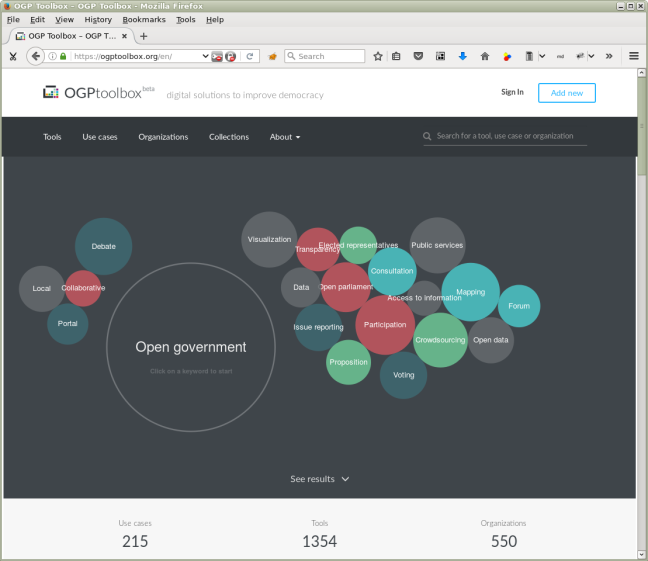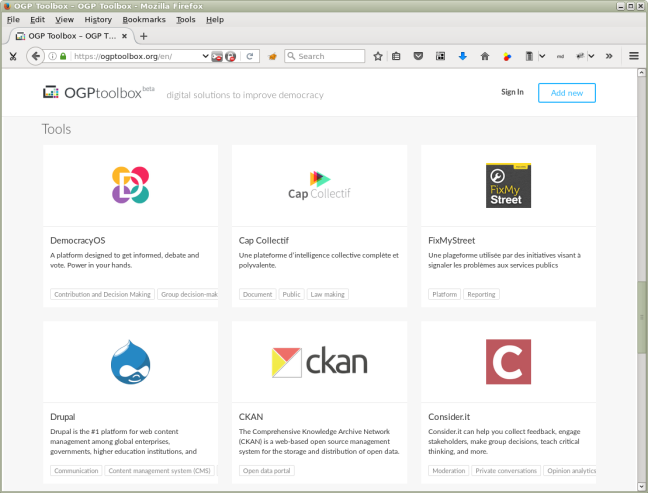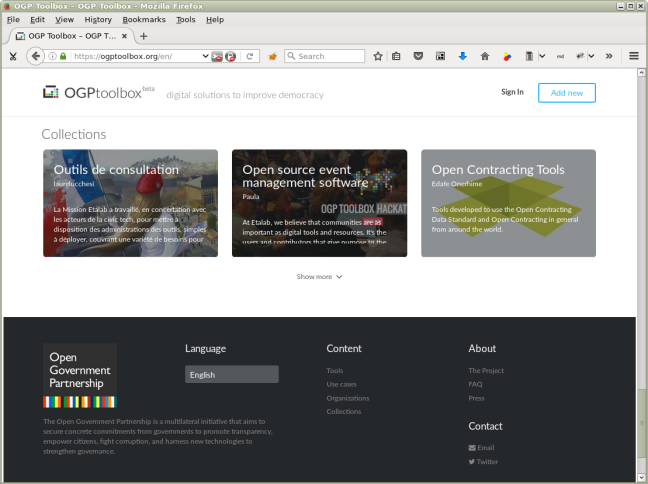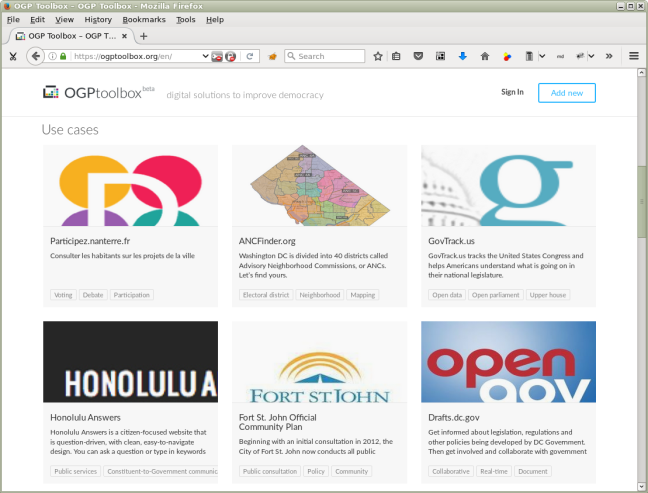The OGP Toolbox is a web portal bringing together digital tools to promote openness in government and improve democracy. The platform aggregates software and services used by governments and civil society around the world for referencing, sharing and re-use. Examples are open data portals, public consultation platforms, tools for monitoring and co-creating legislation, discussion forums, civic tech solutions, and online platforms to monitor the implementation of National Action Plans.

Policy Context
The Open Government Partnership (OGP) is an international initiative to promote transparency, empower citizens, fight corruption, and harness new technologies to strengthen governance. It does so by securing concrete commitments from participating governments, which now number around 70.
France has held the OGP co-chair since October 2016, and Etalab, the French Prime Minister's task force for open data, is the main agency for this presidency,
explains Johan Richer, coordinator of the OGP Toolbox. We started working on the OGP Toolbox in February 2016. One of our inspirations was code.gov, the portal where the US government publishes its open source software. We could not use their platform though, because we were taking a more open, social and international approach.
Tools for public good
At the beginning, the part of the Etalab project that later became the OGP Toolbox was based on the same principles as code.gov,
Richer elaborates. The basic idea is not particularly new or innovative: a centralised, standardised repository or toolbox where developers can shop around and re-use code for their in-house open-source projects. I believe Joinup's Open Source Observatory (OSOR) shares the same mindset.
At the same time, there are many differences between the OGP Toolbox and the code.gov project. The source code for the code.gov platform was released as open source with its launch in November 2016, while our code was already publicly available during its development. So even though the launches of our platforms were almost at the same time, we could not use their code since it was kept closed until then.
But even if we could have used it, we probably wouldn't have because the OGP Toolbox evolved into something really different from other toolboxes. For one, it is not meant to be an official repository for a country's government. It's a catalogue of tools for an open government, in the broader sense. And open source or not, on a proprietary or open platform, we are open and neutral in that regard. Every digital tool that can be used, directly or indirectly, for public good has its place in the OGP Toolbox. Finally, we think it's the users that should decide whether a tool is useful or not. And they do that by voting, arguing, describing, editing, and adding use cases to better illustrate it, for example. That's what makes this an open, social and international initiative.
Description of target users and groups
The OGP Toolbox was specifically designed to help governments and civil society in implementing commitments made in their national OGP action plans. It also encourages cooperation, peer learning and resource sharing between OGP members.
The system can be accessed through the web front-end or an Application Programming Interface API).

Description of the way to implement the initiative
The software development part of the OGP Toolbox started in April 2016. At the launch event for the fourth OGP Summit, France initiated the co-creation process for the platform under the auspices of Etalab, the OGP Support Unit and representatives from civil society. One workshop focused on how to automate harvesting of existing catalogues and how to identify criteria to classify the different software applications. Another workshop considered the uses of the catalogue.
The portal was officially launched in December 2016 at a hackathon organised at the OGP Summit in Paris. The hackathon provided an opportunity for participants to add their tools, improvements and extensions to the system, to test and work on new solutions, to identify new needs, to improve software installation and interoperability, and to write translations (internationalisation).
In previous gatherings (sprints), participants had already worked on harvesting existing catalogues, identifying possible re-uses of the database, packaging software to facilitate automatic installation, and setting a UI/UX benchmark for the portal.
Technology solution
Open Software Base
The OGP Toolbox brings together various open source software tools to create the platform. Information on software packages is automatically aggregated using the Open Software Base (OSB), a toolset previously developed by Etalab. The OSB uses the YAML format to collect and store data on programs from other software repositories and lists. This information is combined with metadata from the local Git repository and then made available for evaluation and comparison of the indexed software packages.
The front-end, i.e. the web interface, has been made available for re-use on GitHub under the AGPL open-source license.
Wikidata
The database of the OGP Toolbox platform is interoperable with Wikidata, the data structure for the knowledge base that underlies various Wikimedia projects, including Wikipedia. The format has been extended in several ways, though, to facilitate the OGP Toolbox platform — for example to include the use cases. At this moment there is therefore no way to feed the collected information back to Wikidata.
Technology choice: Mainly (or only) open standards, Open source softwareMain results, benefits and impacts
OGP Toolbox Association
To guarantuee the continuity of this initiative, last February the OGP Toolbox Association was founded. It aims to empower public, private and civil society actors worldwide by sharing digital tools and resources, in order to promote democracy, transparency, participation and collaboration.
More specifically, the Association's goals are to:
- allow actors to identify the digital tools best suited to their needs, by collecting and describing them in the most objective way possible;
- collaborate to make digital tools more accessible and easier to use;
- create favourable conditions to further the development of better digital tools; and
- foster the sharing of experience between actors and giving feedback on existing tools.
At the launch meeting of the Association, it was decided that the OGP Toolbox project will be officially handed over from Etalab to international civil society. The Association will be led by the Administration council and advised by the Orientation council. Currently the board still consists of five volunteering core members of the OGP Toolbox team at Etalab. Additionally, at the meeting a first roadmap was defined, and several ideas and suggestions proposed for the future development of the project.
Return on investment
The OGP Toolbox currently features 215 use cases, 1354 tools, and 550 organisations in a cross-referenced catalogue. It has been designed as a social network with concrete use cases, technical criteria formulated by the community, and recommendations in the form of tool collections. This allows users to find the most suitable tool for each open government initiative and benefit from the experience of other users who have already implemented existing solutions.
We've incorporated the social aspect into every element of the platform,
Richer explains. So there can be various entries for all the properties of a project, including the description, and the arguments for and against. The property value having the most upvotes is the one that's displayed. All properties together determine the quality and overall ranking of the project. We don't do any moderating or cleansing ourselves; the content is fully crowdsourced.
Volunteers
In the first development phase of the OGP Toolbox platform we worked with two people part-time for ten months,
Richer says, and during the six months since the OGP Summit and hackathon, we have been working with three or four people part-time. We make a lot of commits to our GitLab repository, but we're all volunteers. The OGP itself is not a funding organisation and the French government is focusing on open data, so we are currently looking for funding for this project.
Still, we are committed to working on the digital divide. Computer literacy and trust are key enablers for successfully deploying civic tech. A platform pushed by government is not enough for what they are asking from their citizens. Just like voting, it takes involvement for people to participate, for example in an online consultation.

Track record of sharing
"Toolbox of toolboxes"
At the OGP Summit and hackathon we met a lot of people and organisations that were interested in our platform,
Richer says. They recognise the value of open source and re-use. Most of the traditional open government tools are organisation- and process-driven, but they need to address social questions. For many civic tech applications there already are several open source software tools available. So we provide an inventory of what's already out there.
Organisations that have expressed an interest in our platform itself may want to use it to aggregate different types of applications. Code for Europe, for example, is working on a Transparent Water project. Another organisation is interested in re-using the front-end we've built. In the long term, we want this platform to become the "central toolbox of toolboxes".
Lessons learnt
An open government startup
Etalab can be seen as an open government startup,
says Richer. We aim to introduce the concept of agile software development in government. Over recent months, the OGP Toolbox team has moved from a public agency to more of a civil society organisation, working mainly with citizens and academics. Our main goal is to help society with digital tools for the public good, e.g. to increase trust in government and improve democracy.
Government agencies have no experience in running open source software platforms and tools and interacting with an online community of developers. Civil servants do know how to use online services like the Google applications, but they don't know where to start to install an open-source application, because there is no supplier for it. We receive a lot of these questions specifically from French-speaking countries in Africa — like Madagascar — where people are looking for ways to start using and deploying open source software.
Experiences from others
I noticed that Etalab had a lot of open-source veterans,
Richer continues. Internally, we only use open-source tools, but we are an exception. Other public agencies, even IT departments, don't have any developers in house, which makes it very hard to connect to the developer community.
It should be mandatory for public agencies to check for open-source solutions before purchasing anything else. For each problem there already is a large number of similar projects, allowing for existing software code to be re-used and adapted.
The technical aspect is only one thing though. For people to actually deploy open source, the software has to be mature and to have proven itself. That's why we put so much effort into providing these use cases. The page on the Discourse discussion platform, for example, provides several case studies in addition to a short description. That allows interested people to contact other organisations to learn from their experiences.
The same is true for the opinions visitors can add to the software pages. They are similar to reviews at Amazon, for example, describing experiences from actual users.
Links
- Twitter: https://twitter.com/ogptoolbox
- OGP Toolbox Forum: https://forum.ogptoolbox.org/


